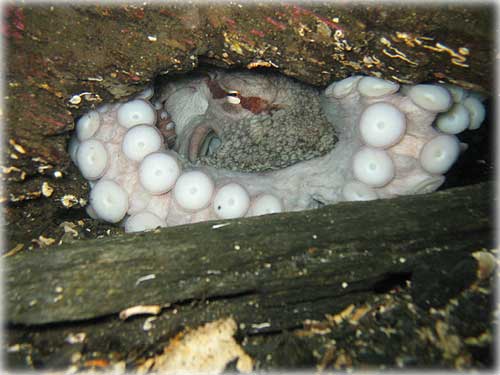 September 08, 2009
"Scientists haven't learned enough about octopus in Alaska to provide for an ecosystem approach to management," said Doug DeMaster, Director of the Alaska Fisheries Science Center. "The knowledge our researchers gain will be valuable on its own, but will be even more so if anyone wants to establish an octopus fishery here. We'd like to get ahead of that possibility with this North Pacific Research Board-funded project." "We've seen earlier investigations into commercial octopus fishing in Alaska and global markets for octopus are leading to increased interest in retention and sale over the past few years," DeMaster added.  its den off of Sunset Drive north of Ketchikan. Photo by Mike Kurth, Ketchikan, AK ©2008
"If we're going to be ready to manage Alaskan octopus as a commercial species, we need know a lot more about them, starting with their reproductive seasons," said lead researcher Elizabeth Conners of the Alaska Fisheries Science Center. The best guess now is that octopus in the Gulf of Alaska and the Bering Sea have distinct reproductive seasons, with mating in the late summer to early fall, spawning in the fall to winter months, and incubation throughout the winter and early spring. Researchers would like to find out whether octopus in Alaska have a seasonal migration pattern, as they do in northern Japan. The main focus of the Alaska Fisheries Science Center study is on giant Pacific octopus (Enteroctopus dofleini), which are the largest in the world. While seven or eight species of octopus can be found in Alaskan waters, giant Pacific octopus are the largest and are most likely to be encountered by fishermen and divers. Giant octopus captured in crab or groundfish pots often weigh 50 lbs or more. Like all octopus, giant Pacific octopus have eight arms lined with sucker disks, swim by forcing water 'jets' through a muscular funnel, and can change skin color and patterns to blend in with their background. They have no bones, and so can squeeze into tight places, but they do have a hard beak allowing them to eat mollusks, crabs, and fish found in Alaska waters. If an octopus can't pull open or bite prey, it will secrete fluid that softens the shell. When the shell is softened, it is scraped away to make a tiny hole. Through this hole, the octopus secretes a toxin that paralyzes the prey and begins to dissolve the connective tissue. The octopus then pulls apart the prey and eats. Giant Pacific octopus are generally shy, but can inflict a painful bite on divers if roughly handled. Researchers are asking local divers near Kodiak, Dutch Harbor and Juneau to watch for octopus. If one is sighted, divers are asked not to disturb the octopus, but to note the general location, time and date of the sighting, and whether other octopus are in the vicinity. Knowing the size of the octopus is helpful-'softball-sized', 'basketball-sized' or 'beach-ball sized' are handy descriptions. Researchers would particularly like divers to report any sightings of octopus dens with eggs in them; octopus eggs are dense strands of tiny yellowish eggs hanging from the roof of a cave or den. Once octopus dens are located in the nearshore water of Kodiak Island in the central Gulf of Alaska and Dutch Harbor in the Aleutian Islands, researchers will re-visit the sites monthly from the late summer or fall of 2010 until the early spring of 2011 to determine when the eggs hatch and when the octopus larvae leave the den. "There has been some work done on octopus biology in British Columbia and Japan, but we need to know what the reproductive seasons in Alaska are as a basis for management policy and we want to know if seasons are the same in the Bering Sea, Gulf of Alaska, and Southeast Alaska," Conners said. Researchers will be examining octopus captured in routine bottom trawl surveys as well as octopus provided by cooperating commercial pot fishermen and fisheries observers. As part of the study, however, researchers will also be testing and developing 'habitat pot' gear specifically designed for catching octopus. A variety of sizes and materials will be used to build small unbaited pots that serve as artifical dens for octopus; a similar gear is currently used in Japanese octopus fisheries. The planned research also includes a pilot tagging study in Dutch Harbor by University of Alaska Fairbanks scientist Reid Brewer. This study will use tiny, bright, flexible tags that will show through the octopus' skin after they are implanted. Both tagging and habitat pot fishing are being developed as techniques to use in future studies for octopus management. Researchers have funding for 20 days of boat time for their octopus work. Ideally, the boat time will be used in a number of shorter trips, spread through the annual cycle. The Alaska Department of Fish and Game will also be participating in the study by providing octopus specimens and helping to test habitat pot gear. To report octopus:
Source of News:
Publish A Letter in SitNews Read Letters/Opinions
|